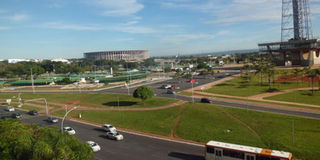Brazil felt like Uganda

One of the streets in Brasilia, the capital of Brazil. PHOTO BY LOMINDA AFEDRARU
What you need to know:
ADVENTURE. Brazil is one of the Latin America countries discovered in the 16th century by Pedro Alvares Cabral a Portuguese navigator. LOMINDA AFEDRARU shares her experience in the capital Brasilia.
Samba and wine are what come to mind when one speaks of Brazil. However, there is more to it.
International Maize Alliance (ABRAMILHO) director, Sergio Luis Bortolozzo, guide of sorts, says Brazil climate is not very different from Africa’s. “Uganda and Brazil lie in the tropics where the Equator passes,” says Bortolozzo.
Agriculture is the major source of income from growing maize, soy bean, coffee, sugarcane, beans and cassava on large scale. One cannot also miss guava, pawpaw, water melon, oranges, banana and vegetables such as eggplant and spinach. It is also evident, as you drive through Brasilia, mango and guava trees line the roadside.
Hospitality
Not many Brazilians speak English but if you are a foreigner, speaking little to none Portuguese, people will try to understand you and help you around. This is because the focus has traditionally been on getting a good education in Portuguese, still difficult in a land where education is far down the list of priorities. Brazilians are warm and often exchange pleasantries. It is easy to feel at home.
Food and street markets
As you walk into the restaurant, you will definitely find cassava chips served with beans. However, Feijoada, is regarded as the national traditional dish though recipes differ region to region. This delicacy comprises black beans stew, beef sausages and pork which is served with baked maize flour, rice and Irish potato. Rice and beans too is a staple usually accompanied with meat or eggs and toasted corn flour. After savouring a meal,it is norm to wash it down with a cup of coffee.
Visiting a street market in Brasilia is one of many authentic experiences in this city that is full of traditions. Market days take place at least twice a week selling tropical fruits and vegetable, seafood, trinkets, antiques, souvenirs to name but a few. Fruit is arranged in bowls in a stall or cart and a few are cut to show off the inside of the fruit. Each bowl of guavas cost 3 Reais, about $1.50. The Ugandan in me could not resist the roast maize and fresh maize in open markets. They also vend coconut juice which people buy in jerrycans. And there was no way my teammates could leave the market without coconut, luxuriously sipping its juice using straws. It looked like a film scene.
About carnival
Brazil is known for its carnival which is celebrated for four working days. According to Bortolozzo the carnival began in the 1830s as a continuation of the Portuguese tradition of celebrating and indulging the day before Lent. In the late 1800s, street musicians and dancing were introduced to celebrate the carnival and each region celebrates according to their custom. For instance, Bahia, in the northeast, incorporates its population’s African influences with integration of reggae and traditional African rhythms with traditional samba music and dancing.
Youth filled, the main city park where young boys wore skirt- like attire and dresses with painted faces. Unfortunately, we left the day before the carnival. I wish we had stayed longer.
faith
Most Brazilian population comprises Catholics. Churches are strewn in Brasilia and the cathedral at heart of the city. However, many Blacks belong to Candomble, a sect which originated in Salvador and Bahia at the beginning of the 19th century, when the first temple was founded. Sergio Bortolozzo says black people that time were not allowed by their masters to belong to the same religion as their masters and they had to start Candomble in order to have a communal belonging.It is believed the religion developed in a cultural tradition of Yoruba, Fon, and Bantu beliefs brought from West Africa by enslaved captives in the Portuguese Empire.
The religion developed in Brazil, influenced by the knowledge of enslaved African priests who continued to teach their mythology, their culture, and language and it absorbed elements of Roman Catholicism. The believers worship Oludumare,a supreme creator who acts as their protector.




